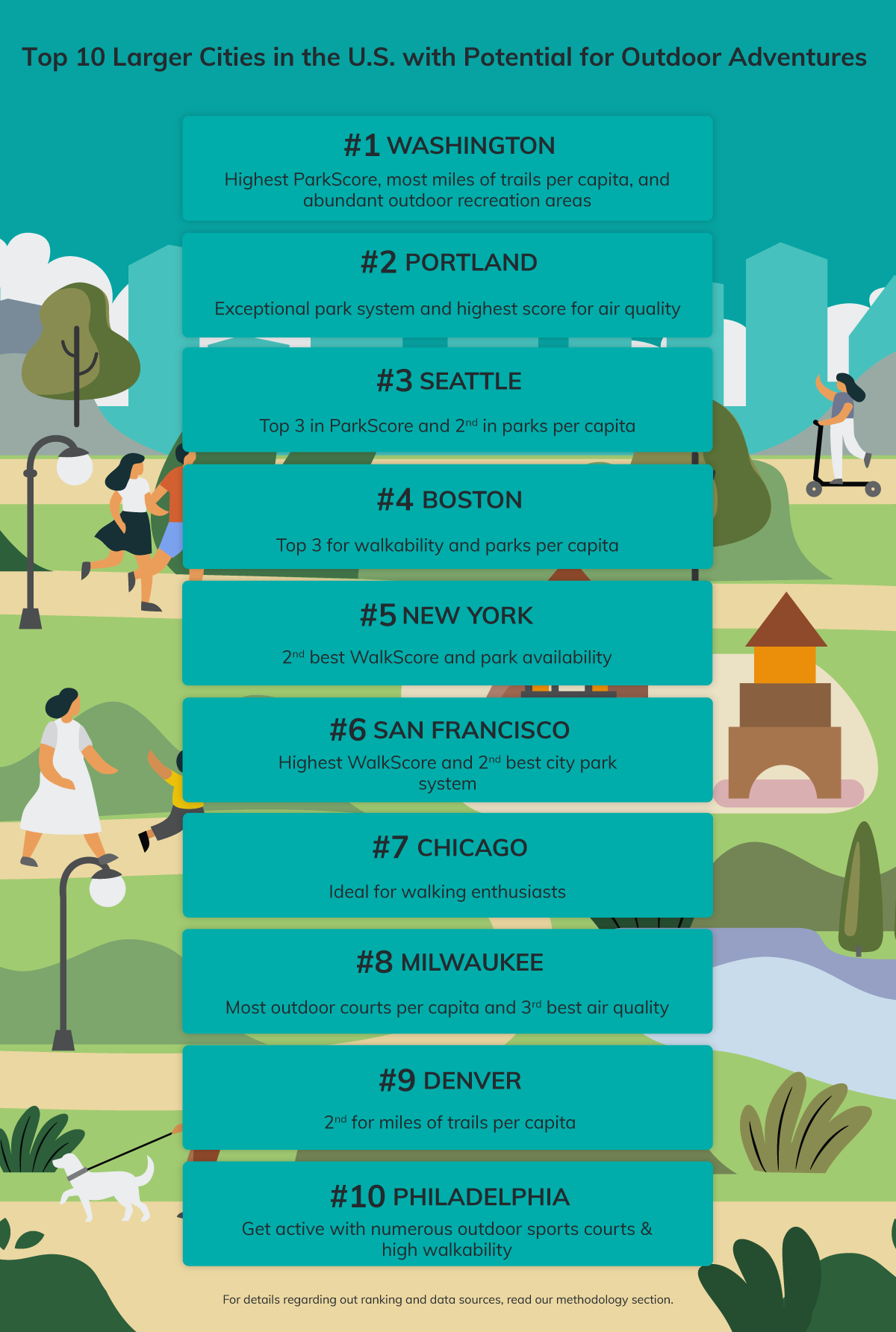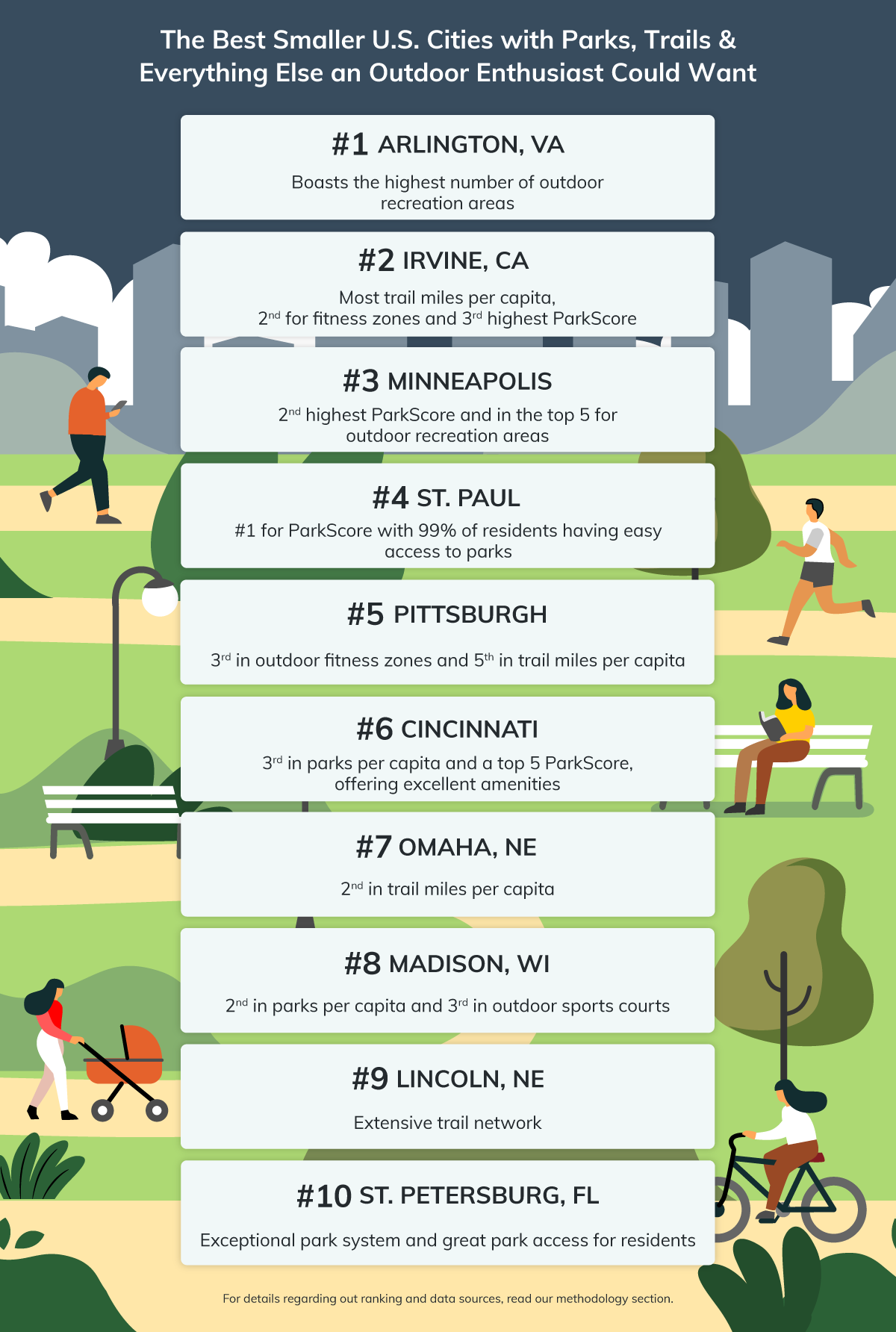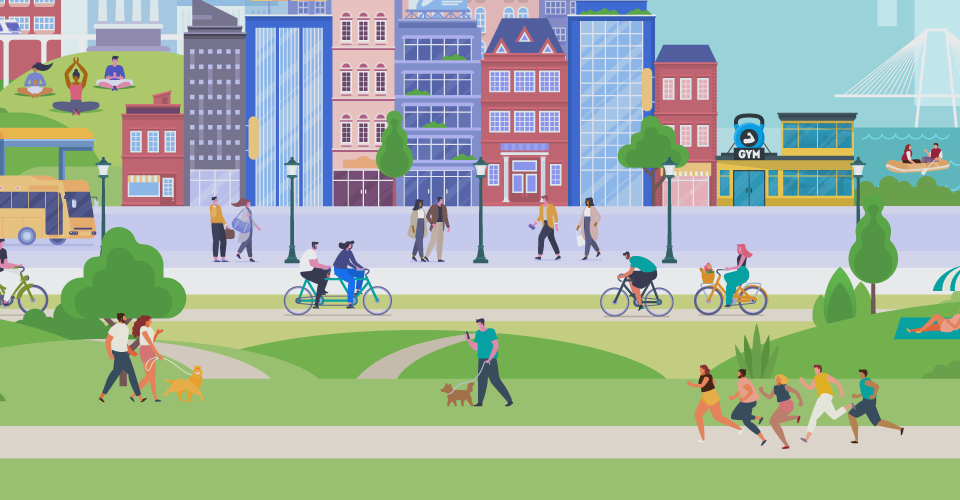Key Highlights:
- Washington D.C. is the top large city for outdoor enthusiasts, with exceptional parks, an extensive trail network, and 22 outdoor recreation areas.
- The Pacific Northwest is home to two of the best large cities for outdoor enthusiasts, with Portland, Ore., leading the pack in terms of air quality.
- Iconic large cities San Francisco, New York, Boston, and Chicago lead the way in walkability.
- Arlington, Va., achieved the highest overall score among cities with fewer than 500,000 residents, thanks to its remarkable 20 outdoor recreation zones.
- Among smaller cities, Irvine, Calif., boasted the highest number of trail miles per capita — with nearly 20 miles of trails for every 10,000 residents.
- The Twin Cities metro area features two of the best park systems in the country, making it easy for residents in Minneapolis and St. Paul to enjoy the outdoors.
We all know that spending time in nature is good for our body and soul. But, with our busy lives, it can be tough to find the time to get away for a weekend-long hike or a long trip to a national park. That’s why we put together a list of the best cities for outdoor enthusiasts who don’t have a lot of time to travel, but still want to incorporate the outdoors into their daily lives.
Plus, these cities not only boast excellent walkability and well-maintained parks, but they also provide a diverse range of outdoor recreational spaces and urban hiking trails all within easy reach. For this ranking, we compared cities based on a number of factors, including their ParkScore, walkability, number of trail miles, sports courts, air quality and more. We also split the list into two categories — large cities (with populations of more than 500,000) and smaller cities (with populations of less than 500,000). This ensures that you can find the perfect place to live, no matter your preference for city size.
Washington, D.C. Leads Among 10 Best Large Cities for Outdoor Enthusiasts
If you’re an outdoor enthusiast seeking the perfect balance between vibrant city life and the great outdoors, then Washington, D.C. should be at the top of your list. Renowned for its exceptional park system, the nation’s capital boasts the highest ParkScore index with an impressive 99% share of residents living within close proximity (a 10-minute walk) to a park, which is a testament to the city’s dedication to accessibility and a high quality of life.
Furthermore, a remarkable 24% of the city’s landscape is dedicated to parks, thereby providing ample room to escape the urban hustle. And, not only does Washington, D.C. prioritize park quantity, but it also excels in outdoor quality: With more than 1,500 miles of trails — an unmatched 23 miles per 10,000 residents — hiking, biking, running and birdwatching opportunities are abundant here.
Moreover, D.C. also offers 22 outdoor recreation areas within a mere 10-mile radius of the city center. From paddling along the tranquil Potomac River to exploring captivating gardens, the options are as diverse as they are enticing. But, that’s not all: Washington, D.C. also takes pride in its top-tier walkability for an invigorating and health-conscious environment year-round.

Portland & Seattle: Abundant Green Spaces & Some of the Best Air Quality Among Large Cities
Despite recent wildfire impacts causing a decline in air quality, Portland, Ore., still managed to achieve the highest air quality score overall among the larger cities included in our study.
Another reason why Portland is a great place to get outside is its park system: The city has more than 5,000 acres of parkland, which includes Forest Park — the largest urban park in the U.S. In fact, Portland ranked fourth on the Trust for Public Land (TPL) ParkScore index. From hiking and biking trails to swimming holes and playgrounds, there’s something for everyone to enjoy in Portland’s parks, further solidifying its well-deserved runner-up status overall.
Likewise, Seattle caters to outdoor enthusiasts with its extensive park system, ranking third among large cities for its impressive park score and narrowly outscoring Portland. Boasting more than 500 parks — including favorites like Discovery Park and Green Lake Park — the city provides abundant green spaces to explore and claims more than six parks per 10,000 residents (the second-highest in the category).
In addition to its sizeable park coverage, the Emerald City has a focus on walkability with pedestrian-friendly neighborhoods that encourage everyone to explore its scenic parks.
Walkability is Best in San Francisco, Milwaukee Claims Highest Number of Outdoor Sports Courts per Capita
If it’s big cities with walkable neighborhoods that you value the most, then San Francisco is the best choice for you. That’s because the city boasted the highest WalkScore among the large cities we compared and even ranked ahead of New York, Boston and Chicago.
Notably, residents in San Francisco need not walk long to find green space: According to the TPL ParkScore, virtually all residents live within a 10-minute walk from a park. What’s more, San Francisco also stood out for being home to one of the most robust park systems in the U.S., ranking second only to Washington, D.C. and placing ahead of both Boston and New York.
San Francisco is a great option for those seeking outdoor recreational activities. Within 10 miles of its city center, the city boasts an impressive 11 outdoor recreational areas, including Golden Gate Park.
Meanwhile, Milwaukee, Wis., caters to the needs of sports enthusiasts with an impressive count of seven outdoor sports courts per 10,000 residents — the highest number of sports courts per capita among the cities we compared.
Other good options in the same category were Philadelphia and Denver, which also scored well for their respective ratios of sports courts per capita. More precisely, Denver stood out for its runner- and biker-friendly infrastructure. The Mile High City was also home to the second-highest number of trail miles per capita, further elevating its appeal to outdoor enthusiasts.
Arlington, Va., Takes Lead Among Smaller Cities, Echoing D.C.’s Triumph
Ranked as the top spot for outdoor enthusiasts among smaller cities, Arlington, Va., is a haven for nature lovers who also appreciate proximity to the bustling Washington, D.C. While it offers a quieter setting, its connection to D.C. is evident through shared outdoor recreation areas — including Theodore Roosevelt Island on the Potomac River, which is a hotspot for water sports.
Additionally, Arlington ensures a variety of attractions for everyone. For instance, the city’s commitment to green spaces was reflected in its fourth-place park ranking. This was supported by TPL data indicating that 99% of residents can access a park within a 10-minute walk. Thus, with its high walkability score, Arlington is easily explorable on foot.
Even as the smallest city among the top 10, Arlington provides the benefits of abundant outdoor activities and parks coupled with the peace of a smaller community. Yet, with only 250,000 residents, Arlington is just one-third the size of D.C. for a relaxed and laidback atmosphere.

Irvine, Calif., Has Most Trail Miles Per Capita Among Smaller Cities
Meanwhile, Irvine, Calif., is a top choice for outdoor enthusiasts who want to explore its extensive park trails and abundant green space. With nearly 20 miles of trails per 10,000 residents, Irvine had the most miles of trails per capita among the smaller cities we compared, as well as the second-highest overall in our ranking after Washington, D.C. Accordingly, there are trails here to suit all levels of experience, from the adventurous Turtle Rock Trail to the leisurely Robert J. Lagomasino Bikeway.
In addition to its lengthy trail system, Irvine also boasts an abundance of parkland. Based on data from TPL, more than one-quarter of the city’s total area is dedicated to parks, giving Irvine one of the highest ratios of parkland to city area in the U.S. Notably, this considerable expanse of parks directly stems from the city’s master-planned design, which was established during the 1960s.
Furthermore, Irvine also scored well for outdoor fitness. As a matter of fact, the city placed second-best for number of outdoor fitness zones among the locations we compared for this ranking. These zones are equipped for exercise and make it easy to get a good workout in the California sunshine.
Minneapolis & St. Paul: Twin Cities for Outdoor Enthusiasts
Nature lovers can also thrive in the Twin Cities, where they can enjoy year-round outdoor activities. In the city rankings, Minneapolis secured the impressive third position, closely followed by St. Paul, Minn., in fourth.
Just edging out its neighbor, Minneapolis’ high-ranking position owes a lot to its local park system; pedestrian-friendly urban design; and extensive network of trails, which incorporate more than five miles of trails per 10,000 residents and offers urban hikes in the summer, as well as ski trails in the winter. Similarly, the city’s park-related investments ensure quality outdoor amenities for both locals and visitors, as well as a high walkability score, which makes it easy to explore without the use of a motorized vehicle.
Similarly, St. Paul also shined as an exceptional city for outdoor enthusiasts. In this case, it boasted the best ParkScore among the smaller population bracket, as well as runner-up nationwide, coming in just behind Washington, D.C. Plus, an impressive statistic within this score is that 99% of residents have a park within a 10-minute walk, thereby highlighting the accessibility of green spaces.
Finally, as neighboring cities in the same metropolitan area, both Minneapolis and St. Paul jointly claimed the fifth position for the abundance of recreation areas per person: Each city takes pride in having five such areas to offer.
Pittsburgh is a City for Fitness & Trails, While Cincinnati; Madison, Wis.; & St. Petersburg, Fla., Stand Out for Parks
Next, Pittsburgh and Cincinnati are two cities with comparable populations that boasted outstanding park systems. Namely, Pittsburgh had a great fitness zone ranking (third) and trail mileage per capita ranking (fifth). At the same time, its ParkScore was ninth overall with excellent points for park amenities. Not to be outdone, Cincinnati also exceled in park amenities, helping it to the sixth-highest ParkScore overall. Additionally, Cincinnati also had the third-highest number of parks per capita.
Heading north, we find Madison, Wis., which claimed the eighth spot for best park system. Madison also had the second-highest ratio of parks per resident among smaller cities and nearly 17 sports courts per 10,000 residents.
Shifting from the Midwest to Florida’s Gulf Coast introduces us to St. Petersburg, Fla., a vibrant city known for its urban beaches and strong focus on green spaces. With the sixth-best ratio of parks to residents in the U.S. — providing eight parks per 10,000 residents — and a #7 ranking in the ParkScore, St. Petersburg is park-centric city to enjoy the outdoors.
Omaha & Lincoln: Abundant Trail Systems Earn High Marks for Outdoor Enthusiasts
In Nebraska, both Omaha and Lincoln offer abundant outdoor recreation opportunities for walking, hiking and biking enthusiasts. In particular, Omaha has nearly 15 miles of trails per 10,000 residents — the second-highest ratio for smaller cities and behind only Irvine, Calif. Similarly, Lincoln scored ninth-best among the smaller cities we compared for this ranking. In terms of trails, it placed sixth among smaller cities. However, according to the EPA Air Quality Index, residents here enjoy somewhat cleaner air than those in Omaha. In fact, with an AQI index of 37, Lincoln placed roughly on par with Norfolk, Va.; Virginia Beach, Va.; and Chesapeake, Va.; on the Atlantic Coast.
No matter what your size preference or favorite outdoor activity, there’s a city on this list that’s perfect for you. So, get out there and start exploring!
Methodology
For this study, we ranked the best places to live for outdoor enthusiasts in the U.S. based on several indicators pertaining to outdoor activities. For better comparability, we ranked cities in two separate brackets based on total population: one containing cities with more than 500,000 residents, and a second list containing cities with fewer than 500,000 residents. Points were awarded as follows:
- ParkScore index: Up to 30 points, as provided by the Trust for Public Land, 2023. The index ranks the parks of the 100 most populous U.S. cities based on 14 measures across five categories — acreage, investment, amenities, access and equity.
- Miles of trails per resident: Up to 15 points, as provided by the Trust for Public Land, 2023.
- Air quality: Up to 20 points, based on data provided by the U.S. Environmental Protection Agency. Air quality data is provided at the county level, 2022.
- Walkability: Up to 10 points, based on data provided by WalkScore.com, 2023.
- Number of outdoor fitness zones per resident: Up to 5 points, as provided by the Trust for Public Land, 2023.
- Number of parks per resident: Up to 5 points, as provided by the Trust for Public Land, 2023.
- Recreation places within city limits: Up to 5 points. This includes boating, campsites, climbing, fishing grounds, hiking, wildlife viewing, and similar activities within 10 miles of city center. Data and mapping are conducted by Recreation.gov, 2023.
- Number of outdoor sport courts per resident: Up to 5 points, as provided by the Trust for Public Land, 2023.
- Miles of walking loop per resident: Up to 5 points, as provided by the Trust for Public Land, 2023.
As some of the data referenced in this article can be subject to change, it is important to note that we present this data as is, without any changes to the source material that was available at the time of our analysis.

